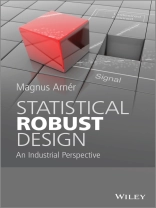A UNIQUELY PRACTICAL APPROACH TO ROBUST DESIGN FROM A
STATISTICAL AND ENGINEERING PERSPECTIVE
Variation in environment, usage conditions, and the
manufacturing process has long presented a challenge in product
engineering, and reducing variation is universally recognized as a
key to improving reliability and productivity. One key and
cost-effective way to achieve this is by robust design —
making the product as insensitive as possible to variation.
With Design for Six Sigma training programs primarily in mind,
the author of this book offers practical examples that will help to
guide product engineers through every stage of experimental design:
formulating problems, planning experiments, and analysing data. He
discusses both physical and virtual techniques, and includes
numerous exercises and solutions that make the book an ideal
resource for teaching or self-study.
* Presents a practical approach to robust design through
design of experiments.
* Offers a balance between statistical and industrial
aspects of robust design.
* Includes practical exercises, making the book useful for
teaching.
* Covers both physical and virtual approaches to robust
design.
* Supported by an accompanying website (href=’http://www.wiley/com/go/robust’>www.wiley/com/go/robust)
featuring MATLAB® scripts and solutions to exercises.
* Written by an experienced industrial design
practitioner.
This book’s state of the art perspective will be of
benefit to practitioners of robust design in industry, consultants
providing training in Design for Six Sigma, and quality engineers.
It will also be a valuable resource for specialized university
courses in statistics or quality engineering.
STATISTICAL AND ENGINEERING PERSPECTIVE
Variation in environment, usage conditions, and the
manufacturing process has long presented a challenge in product
engineering, and reducing variation is universally recognized as a
key to improving reliability and productivity. One key and
cost-effective way to achieve this is by robust design —
making the product as insensitive as possible to variation.
With Design for Six Sigma training programs primarily in mind,
the author of this book offers practical examples that will help to
guide product engineers through every stage of experimental design:
formulating problems, planning experiments, and analysing data. He
discusses both physical and virtual techniques, and includes
numerous exercises and solutions that make the book an ideal
resource for teaching or self-study.
* Presents a practical approach to robust design through
design of experiments.
* Offers a balance between statistical and industrial
aspects of robust design.
* Includes practical exercises, making the book useful for
teaching.
* Covers both physical and virtual approaches to robust
design.
* Supported by an accompanying website (href=’http://www.wiley/com/go/robust’>www.wiley/com/go/robust)
featuring MATLAB® scripts and solutions to exercises.
* Written by an experienced industrial design
practitioner.
This book’s state of the art perspective will be of
benefit to practitioners of robust design in industry, consultants
providing training in Design for Six Sigma, and quality engineers.
It will also be a valuable resource for specialized university
courses in statistics or quality engineering.
Содержание
Preface1 What is Robust Design?
1.1 The Importance of Small Variation
1.2 Variance Reduction
1.3 Variation Propagation
1.4 Discussion
1.4.1 Limitations
1.4.2 The outline of this book
Exercises
2 DOE for Robust Design, Part 1
2.1 Combined Arrays: An Example
2.2 Dispersion Effects
Exercises
References
3 Noise and Control Factors
3.1 Introduction to Noise Factors
3.2 Finding the Important Noise Factors
3.2.1 Reducing the number of noise factors
3.3 How to Include Noise in a Designed Experiment
3.3.1 How to include noise in experimentation
3.4 Control Factors
Exercises
References
4 Response, Signal, and P diagrams
4.1 The Idea of Signal and Response
4.2 Ideal Functions and P Diagrams
4.3 The Signal
Exercises
5 DOE for Robust Design, Part 2
5.1 Combined and Crossed Arrays
5.2 Including a Signal in a Designed Experiment
5.2.1 Combined arrays with a signal
5.2.2 Inner and outer arrays with a signal
5.3 Crossed Arrays versus Combined Arrays
5.3.1 Differences in factor aliasing
5.4 Crossed Arrays and Split-Plot Designs
5.4.1 Limits of randomization
5.4.2 Split-plot designs
Exercises
References
6 Smaller-the-Better and Larger-the-Better
6.1 Different Types of Responses
6.2 Failure Modes and Smaller-the-Better
6.3 Larger-the-Better
6.4 Operating Window
Exercises
References
7 Regression for Robust Design
7.1 Graphical Techniques
7.2 Analytical Minimization of (g0(z))2
7.3 Regression and Crossed Arrays
Exercises
8 Mathematics of Robust Design
8.1 Notational System
8.2 The Objective Function
8.2.1 Multidimensional problems
8.2.2 Pareto optimality
8.3 ANOVA for Robust Design
8.3.1 Traditional ANOVA
8.3.2 Functional ANOVA
Exercises
References
9 Design and Analysis of Computer Experiments
9.1 Overview of Computer Experiments
9.2 Experimental Arrays for Computer Experiments
9.2.1 Screening designs
9.2.2 Space filling designs
9.3 Response Surfaces
9.4 Optimization
Exercises
References
10 Monte Carlo Methods for Robust Design
10.1 Geometry Variation
10.2 Geometry Variation in Two Dimensions
10.3 Crossed Arrays
11 Taguchi and His Ideas on Robust Design
11.1 The Experimental Arrays
11.1.1 The nature of inner arrays
11.1.2 Crossing the arrays
11.2 Signal to Noise Ratios
11.3 Some Other Ideas
Exercises
References
Appendix A Loss Functions
Exercises
References
Appendix B Data to chapter 2
Appendix C Data to chapter 5
Appendix D Data to chapter 6
Index
Об авторе
Magnus Arnér, Tetra Pak Packaging Solutions,Sweden
язык английский ● Формат EPUB ● страницы 248 ● ISBN 9781118841952 ● Размер файла 5.6 MB ● издатель John Wiley & Sons ● опубликованный 2014 ● Загружаемые 24 месяцы ● валюта EUR ● Код товара 2927213 ● Защита от копирования Adobe DRM
Требуется устройство для чтения электронных книг с поддержкой DRM












